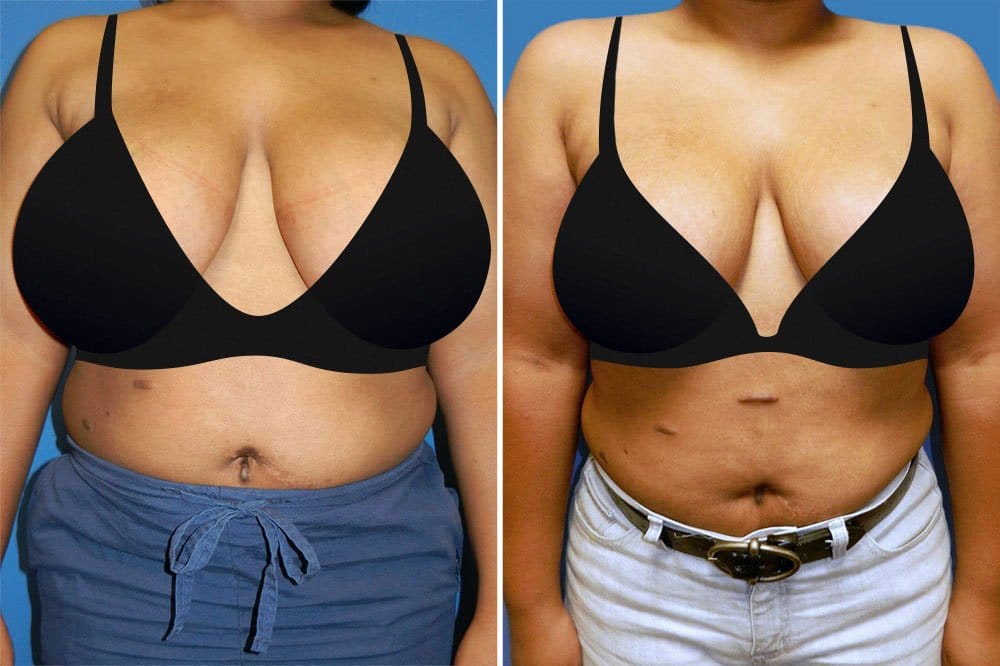Breast Reduction Surgery
Say goodbye to discomfort and hello to more youthful, lifted breasts
Breast reduction patients are among the most satisfied with their results of all plastic surgery patients. Having smaller, lighter breasts that are better proportioned to your body can not only help relieve pain and discomfort, but you will also enjoy greater freedom in many of your daily activities. Imagine finding bras that fit comfortably, enjoying exercise without feeling self-conscious about your breasts, and feeling more confident in your appearance every day. Read on to discover how a breast reduction with top Little Rock cosmetic surgeon Dr. Rhys Branman can help improve your shape and comfort.

What is breast reduction?
Breast reduction also known as reduction mammoplasty, is a surgical procedure aimed at reducing the size and weight of large breasts. This surgery involves the removal of excess breast fat, glandular tissue, and skin to achieve a breast size in proportion with the patient’s body and to alleviate discomfort associated with overly large breasts. Many women choose to undergo this procedure to address physical issues such as back and neck pain, skin irritation under the breasts, and posture problems. The surgery not only helps in relieving these physical ailments but also can improve the patient’s self-image and ability to participate in physical activities.
“If there were one word to describe my experience it would be FABULOUS! I had been thinking about having breast reduction/lift surgery for years. And now, I could kick myself for not having it done sooner. I have more confidence and way less back pain. Dr. Rhys Branman took me from a 34DDD to a 34 D, the perfect size for my height and build. I simply could not be happier with the outcome.”
Best Breast Reduction Candidates
Good candidates for breast reduction surgery are individuals experiencing physical discomfort due to large breasts, those with skin irritation under the breast area, and those seeking relief from psychological distress related to breast size.
Ideal candidates for any plastic or cosmetic surgical procedure should be in good general health, non-smokers, and have realistic expectations about the outcomes of their surgery. On the other hand, those not recommended for this procedure include individuals with serious health issues that impair healing, active smokers unwilling to quit, and those with unrealistic expectations about the achievable results.
To determine if you are a candidate for breast reduction, it’s important to consult with a certified cosmetic surgeon that has experience specifically in breast reduction surgeries, such as Dr. Rhys Branman. He will meet with you one-on-one to assess your overall health, discuss your goals and concerns, and evaluate whether this procedure is appropriate for your specific needs and conditions.

Your Breast Reduction with Dr. Branman
The Consultation
During a consultation, Dr. Branman will answer any questions you may have about this procedure and evaluate your current breast size and shape. He will discuss with you the various factors that can affect your results, such as your age, any existing asymmetry, and your natural body proportions.
If Dr. Branman agrees that surgery will help you achieve your goals, and you wish to proceed, he may advise you to get a mammogram to establish a baseline and ensure your breast tissue is healthy before having surgery. Dr. Branman will also provide specific instructions on surgery preparation, including guidelines on eating, drinking, smoking, and taking or avoiding certain vitamins and medications.
The Surgery Process: What to Expect
A breast reduction is typically an outpatient procedure performed at our accredited surgical facility. The operation usually requires about 2-3 hours, using general anesthesia.
During your breast reduction surgery, Dr. Branman will use liposuction to remove excess fat, glandular tissue and skin, as well as raise the nipple/areola complex, and reshape the smaller breast into a more lifted, youthful position to eliminate sagging. The result is a smaller, more aesthetically pleasing breast that feels firmer and fits more comfortably into clothing.
Breast Reduction Incision Techniques
A few different incision techniques can be used to perform a breast reduction, each of which result in some degree of scarring. The best technique for you is largely dependent on how much breast tissue needs to be removed to achieve the desired result.
The most commonly used breast reduction incision is the “anchor” shaped incision. This technique allows for the most dramatic reduction in breast tissue, and results in three scars: around the nipple, along the outline of the areola, one vertically down from the areola, and a third following the natural crease underneath the breast.
For patients who only need a modest reduction, a vertical or “lollipop” technique may suffice. This technique eliminates the incision in the inframammary fold (the crease underneath the breast), so there are only scars around the outline of the areola and vertically on the lower portion of the breast.
For each patient, Dr. Branman considers what will achieve the best aesthetic improvement with the smallest scar and the least amount of risk. Both of these techniques result in scars that, with proper care, will fade significantly over time and are easily hidden by clothing, even bikini tops.
For each breast reduction patient, Dr. Branman carefully considers what will achieve the best aesthetic improvement with the smallest scar and the least amount of risk.

Recovery After Breast Reduction Surgery
After your breast reduction surgery is complete, you’ll be given an elastic bandage or special bra to wear over the gauze dressings. Bruising and swelling should be expected for the first few days. Dr. Branman will prescribe pain medication to help alleviate discomfort. Stitches are removed after about 7-10 days.
After a short recovery period, your bandages or surgical bra will be replaced by a soft support bra, which must be worn for 3-4 weeks. It is normal to have some temporary loss of feeling in the nipples and breast skin. Normal sensation typically returns over the next 6 weeks. In some patients, numbness can last a year or longer, particularly around the nipples.
Your Reduction Results
After your breast reduction surgery, you can expect to enjoy smaller, lighter, and more proportionate breasts, leading to improved physical comfort and appearance. While some results are immediate, post-operative swelling and bruising may initially obscure the final outcome. The full reduction results typically become evident after several months as the swelling subsides and the breasts settle into their new shape. While the results provided by breast reduction are long-lasting, they may not be permanent, as factors like aging, weight fluctuations, hormonal changes, and gravity can affect the breasts over time, potentially leading to changes in shape and size. Strictly adhering to your recovery instructions to a T in the months following your procedure, and then continuing to maintain a stable weight and healthy lifestyle in the years that follow, can help significantly in preserving the results of your surgery.
Frequently Asked Questions
How much does breast reduction surgery in Little Rock, AR cost?
The cost of breast reduction surgery in Little Rock, AR varies depending on individual patient needs and specific circumstances. Many medical insurances contribute to the cost if the surgery is deemed medically necessary. For those without insurance coverage or seeking additional financial options, we offer financing plans as well as monthly specials. To get a precise quote for your personal case, please schedule an appointment with Dr. Branman.
Will insurance cover my breast reduction surgery?
Insurance coverage for a breast reduction depends on whether the procedure is deemed medically necessary. Most insurance companies require documentation demonstrating that the surgery is needed to alleviate medical issues such as back pain, skin irritation, or other health problems caused by large breasts. It’s important to consult with your insurance provider to understand the specific criteria and documentation required for coverage, as policies and requirements can vary widely between insurers.
How long does recovery take?
Healing from breast reduction surgery is a gradual process that requires patience. While you will be able to walk around after the first day, expect to take 1 to 2 weeks away from work, depending on the nature of your work and how you feel. If you have a desk job, you can probably go back to work fairly quickly. You should not do anything that requires lifting or reaching high above your head for 3-4 weeks, such as heavy cleaning or carrying groceries. You will also need help caring for younger children for the first couple of weeks.
Dr. Branman will provide detailed instructions regarding recovery and the resumption of activities. You will need to avoid strenuous exercise, such as running or weight training, for about 1 month. After that, we recommend that you resume these activities slowly. It is important not to do too much too soon.
What are the risks of breast reduction surgery?
A breast reduction isn’t a simple surgery, but it is generally safe when performed by a qualified, experienced cosmetic surgeon. All surgeries carry a risk of complications, including infection, reaction to anesthesia, or poor healing that results in prominent scars. You can reduce your likelihood of complications by closely following Dr. Branman’s instructions before and after surgery.
With breast reduction, there is some risk of permanent loss of nipple sensation. Additionally, the ability to breastfeed may be compromised for some patients, depending on the extent of surgery. Future pregnancies or significant changes in weight can also affect your breast size and shape. We are happy to talk with you about any concerns you may have about these factors.
Does a reduction include a breast lift?
Yes, a breast reduction includes many aspects of a breast lift (mastopexy). During the procedure, excess breast tissue, fat, and skin are removed, and the remaining tissue is reshaped to lift and firm the breast contour. The nipples and areolas may also be repositioned or resized to match the newly shaped breasts, further enhancing the breast’s lifted and youthful appearance.
“Dr. Branman is an artist when it comes to breast augmentation. The scars are almost faded already and my breasts are so perky and youthful. I feel feminine and pretty in a swim top, and I love my new breasts as if I’d had them my whole life. They are proportionate and balanced in every way. I feel like I went to the best cosmetic breast augmentation surgery center in the state.”

If you have questions or would like to learn more about your options for breast reduction surgery, we are here to help. Dr. Branman has been helping Little Rock breast reduction patients since 1998 meet their cosmetic goals, and he would be happy for you to come in for a consultation. Contact us to schedule a consultation with award-winning breast surgeon Dr. Rhys Branman at our cosmetic surgery center in Little Rock, AR.
- Key Benefits
- Glossary
- Relief from Physical Discomfort: Reduction in back, neck, and shoulder pain that is often caused by the weight of large breasts.
- Improved Posture: Lighter, smaller breasts can help in correcting posture issues that may have developed due to the constant strain of carrying excess weight.
- Enhanced Physical Activity: A reduction in breast size can make it easier and more comfortable to engage in physical activities like running, yoga, or sports.
- Reduced Skin Irritation: Breast reduction lessens the risk of skin irritation and infections that can occur under the breast fold due to friction and sweat.
- Decreased Breast Sagging: The procedure can help in lifting and reshaping the breasts, thereby significantly reducing sagging.
- Improved Sleep Quality: Reduction in discomfort can lead to better sleep quality and more comfortable sleeping positions.
- Anesthesia: Medication used to prevent pain during surgery. Typically, general anesthesia is used during breast reduction procedures.
- Areola: The pigmented skin surrounding the nipple, which may be resized or repositioned during breast reduction surgery.
- Asymmetry: A difference in size, shape, or position between the two breasts, which breast reduction surgery can address.
- Breast Tissue: The combination of glandular tissue and fat that makes up the breast, often reduced during surgery.
- Consultation: The initial meeting with the surgeon to discuss goals, options, and the surgical process.
- Drain: A small tube placed under the skin after surgery to remove excess fluids and reduce swelling.
- Excess Skin: The skin removed during breast reduction to create a more proportionate breast size.
- Fat Necrosis: A condition where fat cells die and create firm lumps, sometimes occurring after breast surgery.
- Follow-Up: Post-surgical visits to the surgeon to monitor healing and address any concerns.
- Glandular Tissue: The tissue in the breast responsible for producing milk, which may be reduced during surgery.
- Hematoma: A collection of blood outside of blood vessels, sometimes occurring after surgery and requiring attention.
- Incision: The surgical cut made to remove excess tissue and skin during breast reduction.
- Inverted T Scar: A common scar pattern from breast reduction, shaped like an anchor or inverted T.
- Liposuction: A technique that may be used alongside breast reduction to remove excess fat from the breast.
- Mammogram: An X-ray of the breast, sometimes required before and after breast reduction surgery.
- Nipple Repositioning: The process of moving the nipple to a higher position on the breast during surgery for a more natural appearance.
- Nipple Sensation: The feeling in the nipple area, which can be temporarily altered or lost after surgery.
- Over-Resection: Removal of too much breast tissue, leading to smaller-than-desired breasts.
- Reduction Mammaplasty: The medical term for breast reduction surgery.
- Recovery: The period following surgery when the body heals, typically lasting several weeks.
- Reshaping: The process of contouring the remaining breast tissue to create a more natural and proportional shape.
- Scarring: Marks left on the skin after the surgical incisions heal, often fading over time.
- Sutures: Stitches used to close incisions after breast reduction surgery.
- Symmetry: The balanced size and shape of the breasts after reduction surgery.
- Tissue Resection: The surgical removal of breast tissue to achieve the desired breast size.
- Volume: The size or fullness of the breast, which is decreased during reduction surgery.
